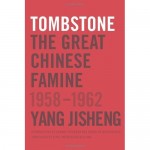Last updated on November 26, 2012
Courtesy of one of the students in my development seminar, here are links to a two-part NPR story about China’s famine of 1958-1962: part 1 and part 2.
Between 1958 and 1962, an estimated 20 to 43 people died of hunger in China, which China’s official statistics claiming 15 million deaths and the highest estimates reporting a death toll of 45 million. For comparison, the death toll from World War 1 is estimated to be about 17 million. During the Chinese famine, people eventually survived on anything they could find, eventually going so far as to eat their dead and their own children.
The NPR story discusses Tombstone, a book which just came out in English and which took Chinese reporter Yang Jisheng 10 years of working in secrecy to write. I’m about 100 pages into the book. It is a fascinating and monumental account of China’s Great Famine. And as one might reasonably expect, it is banned in China.
In Yang’s own words, the title of the book comes from the fact that is meant to be a tombstone for his father, whom he saw die of hunger in the early days of the famine, as well as a tombstone for the bankrupt ideology which made China’s Great Famine — which is still euphemistically referred to in China as the Three Years of Natural Disasters — possible.
Amartya Sen’s observation that “starvation is the characteristic of some people not having enough food to eat. It is not the characteristic of there being not enough food to eat. While the latter can be a cause of the former, it is but one of many possible causes” (emphasis in the original) holds true in the Chinese case.
Indeed, as part 1 of the NPR story has it:
It was April 1959, a year after China launched its Great Leap Forward, a political movement forcing the population to drop everything and make steel in backyard furnaces so China could catch up with the US and Britain. The country’s entire population ate in collective kitchens, pots and pans were confiscated, and farm work was stopped.
Provinces reported record grain hauls — exaggerating their figures and resulting in huge procurement targets, leaving nothing for peasants to eat. Millions starved to death.
Another good read (and perhaps a more accessible one than Tombstone, which some might find too detailed) is Frank Dikötter’s Mao’s Great Famine.
(HT: Jessica Isaacs.)
